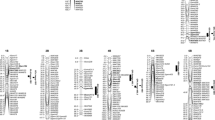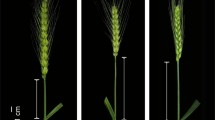Abstract
Recombinant inbred lines of the International Triticeae Mapping Initiative (ITMI) mapping population were used to localize genetic loci that affect traits related to the free-threshing habit (percent threshability, glume tenacity, and spike fragility) and to spike morphology (spike length, spikelet number, and spike compactness) of wheat (Triticum aestivum L.). The ITMI population was planted in three environments during 1999 and 2000, and phenotypic and genotypic data were used for composite interval mapping. Two quantitative trait loci (QTL) that consistently affected threshability-associated traits were localized on chromosomes 2D and 5A. Coincident QTL on the short arm of 2D explained 44% of the variation in threshability, 17% of the variation in glume tenacity, and 42% of the variation in rachis fragility. QTL on chromosomes 2D probably represent the effect of Tg, a gene for tenacious glumes. Coincident QTL on the long arm of 5A explained 21% and 10% of the variation in glume tenacity and rachis fragility, respectively. QTL on 5A are believed to represent the effect of Q. Overall, free-threshing-related characteristics were predominantly affected by Tg and to a lesser extent by Q. Other QTL that were significantly associated with threshability-related traits in at least one environment were localized on chromosomes 2A, 2B, 6A, 6D, and 7B. Four QTL on chromosomes 1B, 4A, 6A, and 7A consistently affected spike characteristics. Coincident QTL on the short arm of chromosome 1B explained 18% and 7% of the variation in spike length and spike compactness, respectively. QTL on the long arm of 4A explained 11%, 14%, and 12% of the variation in spike length, spike compactness, and spikelet number, respectively. A QTL on the short arm of 6A explained 27% of the phenotypic variance for spike compactness, while a QTL on the long arm of 7A explained 18% of the variation in spikelet number. QTL on chromosomes 1B and 6A appear to affect spike dimensions by modulating rachis internode length, while QTL on chromosomes 4A and 7A do so by affecting the formation of spikelets. Other QTL that were significantly associated with spike morphology-related traits, in at least one environment, were localized on chromosomes 2B, 3A, 3D, 4D, and 5A.






Similar content being viewed by others
References
Ausemus ER, McNeal FH, Schmidt JW (1967) Genetics and inheritance. In: Quisenbeery KS, Reitz LP (eds) Wheat and wheat improvement. ASA CSSA, SSSA Publ, Madison, pp225–267
Basten CJ, Weir BS, Zeng ZB (1994) zmap–a QTL cartographer. In: Smith C, Gavora JS, Chesnais BBJ, Fairfull W, Gibson JP, Kennedy BW, Burnside EB (eds) Proc 5th World Cong Genet Appl Livestock Prod: Comput Strategies Software, vol 22. University of Guelph, Guelph, Ontario, Canada, pp 65–66
Basten CJ, Weir BS, Zeng ZB (1999) QTL cartographer version 1.13. A reference manual and tutorial for QTL mapping. http://statgen.ncsu.edu/qtlcart/index.php
Börner A, Schumann E, Furste A, Coster H, Leithold B, Röder MS, Weber WE (2002) Mapping of quantitative trait loci determining agronomic important characters in hexaploid wheat (Triticum aestivum L.). Theor Appl Genet 105:921–936
Chen Q-F, Yen C, Yang J-L (1998) Chromosome location of the gene for brittle rachis in the Tibetan weedrace of common wheat. Genet Resour Crop Evol 45:407–410
Faris JD, Fellers JP, Brooks SA, Gill BS (2003) A bacterial artificial chromosome contig spanning the major domestication locus Q in wheat and identification of a candidate gene. Genetics 164:311–321
Jofuku KD, den Boer BGW, Van Montagu M, Okamuro JK (1994) Control of Arabidopsis flower and seed development by the homeotic gene APETALA2. Plant Cell 6:1211–1225
Kabarity A (1966) On the origin of the new cultivated wheat. II. Cytogenetical studies on the karyotypes of some Triticum macha varieties. Beitr Biol Pflanzen 42:339–346
Kato K, Miura H, Akiyama M, Kuroshima M, Sawada S (1998) RFLP mapping of the three major genes, Vrn1, Q, and Bl, on the long arm of chromosome 5A of wheat. Euphytica 101:91–95
Kato K, Miura H, Sawada S (2000) Mapping QTLs controlling grain yield and its components on chromosome 5A of wheat. Theor Appl Genet 101:1114–1121
Kerber RE, Dyck PL (1969) Inheritance in hexaploid wheat of leaf rust resistance and other characters derived from Aegilops squarrosa. Can J Genet Cytol 11:639–647
Kerber RE, Rowland GG (1974) Origin of the threshing character in hexaploid wheat. Can J Genet Cytol 16:145–154
Kimber G, Sears ER (1983) Assignment of genome symbols in Triticeae. In: Sakamoto S (ed) Proc 6th Int Wheat Genet Symp. Maruzen, Kyoto, pp 1195–1196
Korzun V, Röder MS, Ganal MW, Worland AJ, Law CN (1998) Genetic analysis of dwarfing gene (Rht8) in wheat. Part I. Molecular mapping of Rht8 on the short arm of chromosome 2D of bread wheat (Triticum aestivum L.) Theor Appl Genet 96:1104–1109
Kuspira J, Unrau J (1957) Genetic analyses of certain characters in common wheat using whole chromosome substitution lines. Can J Plant Sci 37:300–326
Leighty CE, Boshnakian S (1921) Genetic behaviour of the spelt form in crosses between Triticum spelta and Triticum aestivum. J Agric Res 7:335–364
Li WL, Nelson JC, Chu CY, Shi LH, Huang SH, Liu DJ (2002) Chromosomal locations and genetic relationships of tiller and spike characters in wheat. Euphytica 125:357–366
Luo MC, Yang ZL, Dvořák J (2000) The Q locus of Iranian and European spelt wheat. Theor Appl Genet 100:602–606
MacKey J (1954) Neutron and X-ray experiments in wheat and a revision of the speltoid problem. Hereditas 40:65–180
MacKey J (1966) Species relationships in Triticum. Hereditas 2:237–276
Marino CL, Nelson JC, Lu YH, Sorrels ME, Leroy P, Lopes CR, Hart GE (1996) RFLP-based linkage maps of the homoeologous group 6 chromosomes of hexaploid wheat (Triticum aestivum L. em. Thell). Genome 39:359–366
Muramatsu M (1963) Dosage effect of the spelt gene q of hexaploid wheat. Genetics 48:469–482
Muramatsu M (1986) The vulgare super gene, Q: its universality in durum wheat and its phenotypic effects in tetraploid and hexaploid wheats. Can J Genet Cytol 28:30–41
Nelson JC, Sorrels ME, Van Deynze AE, Lu YH, Atkinson M, Bernard M, Leroy P, Farris JD, Anderson JA (1995a) Molecular mapping of wheat: major genes and rearrangements in homoeologous groups 4, 5, and 7. Genetics 141:721–731
Nelson JC, Van Deynze AE, Autrique E, Sorrels ME, Lu YH, Merlino M, Atkinson M, Leroy P (1995b) Molecular mapping of wheat. Homoeologous group 2. Genome 38:516–524
Nelson JC, Van Deynze AE, Autrique E, Sorrels ME, Lu YH, Negre S, Bernard M, Leroy P (1995c) Molecular mapping of wheat. Homoeologous group 3. Genome 38:525–533
Okamuro JK, Caster B, Villaroel R, Van Montagu M, Jofuku KD (1997) The AP2 domain of APETALA2 defines a large new family of DNA binding proteins in Arabidopsis. Proc Natl Acad Sci USA 94:7076–7081
Pestsova E, Ganal MW, Röder MS (2000) Isolation and mapping of microsatellite markers specific for the D genome of bread wheat. Genome 43:689–697
Pugsley AT (1966) The photoperiodic sensitivity of some spring wheats with special reference to the variety Thatcher. Aust J Agric Res 17:591–599
Rao MVP (1972) Mapping of the compactum gene C on chromosome 2D of wheat. Wheat Inf Serv 35:9
Rao MVP (1977) Mapping of the sphaerococcum gene 's' on chromosome 3D of wheat. Cereal Res Commun 5:15–17
Röder MS, Korzun V, Wendehake K, Plaschke J, Tixier MH, Leroy P, Ganal MW (1998) A microsatellite map of wheat. Genetics 149:2007–2023
SAS Institute (1996) SAS/STAT user's guide. Version 6.12. SAS Institute, Cary, N.C.
Sears ER (1947) The sphaerococcum gene in wheat. Genetics 32:102–103
Sears ER (1954) The aneuploids of common wheat. Mo Agric Exp Stn Res Bull 572
Simonetti MC, Bellomo MP, Laghetti G, Perrino P, Simeone R, Blanco A (1999) Quantitative trait loci influencing free-threshing habit in tetraploid wheats. Genet Resour Crop Evol 46:267–271
Sourdille P, Tixier MH, Charmet G, Gay G, Cadalen T, Bernard S, Bernard M (2000) Location of genes involving in ear compactness in wheat (Triticum Aestivum) by means of molecular markers. Mol Breed 6:247–255
Tsunewaki K (1966) Comparative gene analysis of common wheat and its ancestral species. II. Waxiness, growth habit and awnedness. Jpn J Bot 19:175–229
Unrau J (1950) The use of monosomes and nullisomes in cytogenetic studies in wheat. Sci Agric 30:66–89
Van Deynze AE, Dubcovsky J, Gill KS, Nelson JC, Sorrels ME, Dvorak J, Gill BS, Lagudah ES, McCouch SR, Appels R (1995) Molecular-genetic maps for group 1 chromosomes of Triticeae species and their relation to chromosomes in rice and oat. Genome 38:45–59
Villareal RL, Mujeeb-Kazi A, Rajaram S (1996) Inheritance of threshability in synthetic hexaploid (Triticum turgidum and T. tauschii) by T. aestivum crosses. Plant Breed 115:407–409
Watanabe N, Ikebata N (2000) The effects of homoeologous group 3 chromosomes on grain colour dependent seed dormancy and brittle rachis in tetraploid wheat. Euphytica 115:215–220
Worland AJ (1996) The influence of flowering time genes on environmental adaptability in European wheats. Euphytica 89:49–57
Zeng Z (1993) Theoretical basis for separation of multiple linked gene effects in mapping quantitative trait loci. Proc Natl Acad Sci USA 90:10972–10976
Zeng Z (1994) Precision mapping of quantitative trait loci. Genetics 136:1457–1468
Acknowledgements
We thank Dr. C. J. Peterson for use of field facilities and Elizabeth Yoon, Ryan Millimaki, and Jumnit Hong for their technical assistance. A graduate scholarship to C. Jantasuriyarat from the Royal Thai Government and funding from the Oregon Wheat Commission are gratefully acknowledged.
Author information
Authors and Affiliations
Corresponding author
Additional information
Communicated by J. Dvorak
Rights and permissions
About this article
Cite this article
Jantasuriyarat, C., Vales, M.I., Watson, C.J.W. et al. Identification and mapping of genetic loci affecting the free-threshing habit and spike compactness in wheat (Triticum aestivum L.). Theor Appl Genet 108, 261–273 (2004). https://doi.org/10.1007/s00122-003-1432-8
Received:
Accepted:
Published:
Issue Date:
DOI: https://doi.org/10.1007/s00122-003-1432-8




